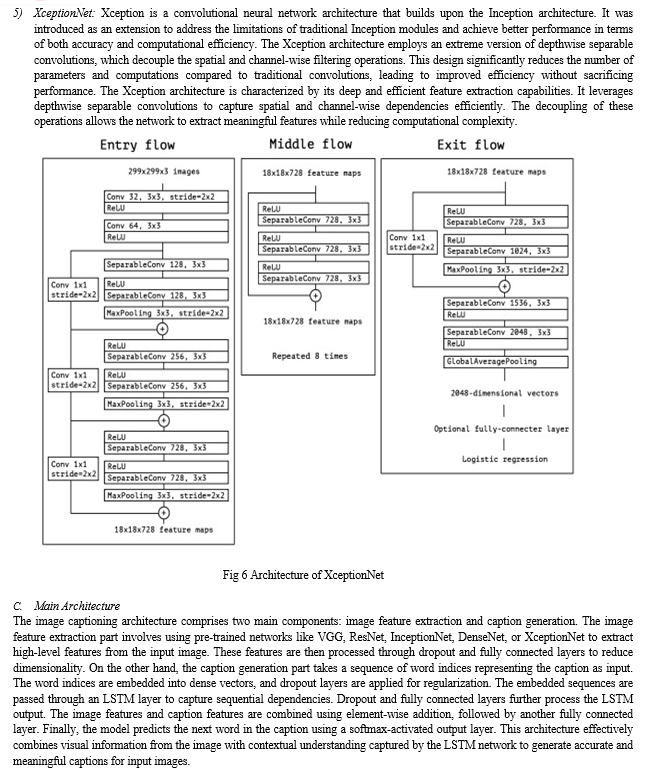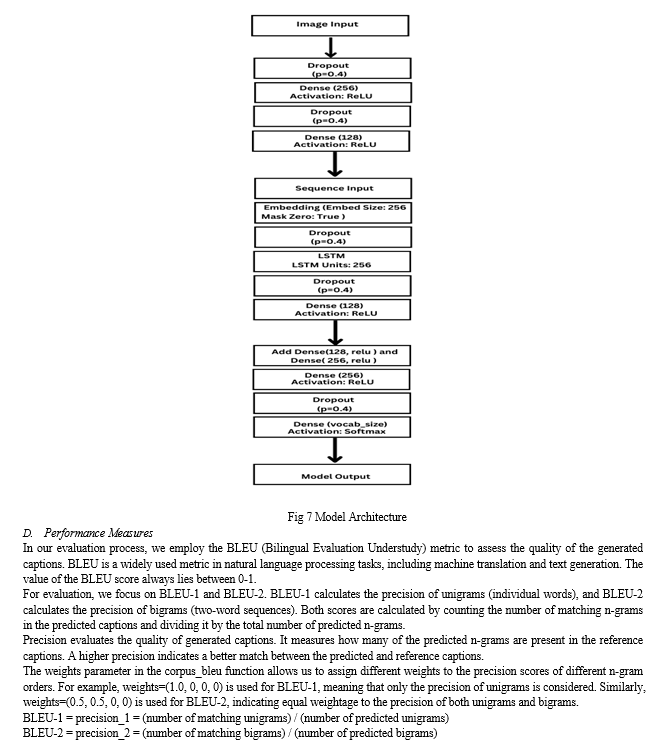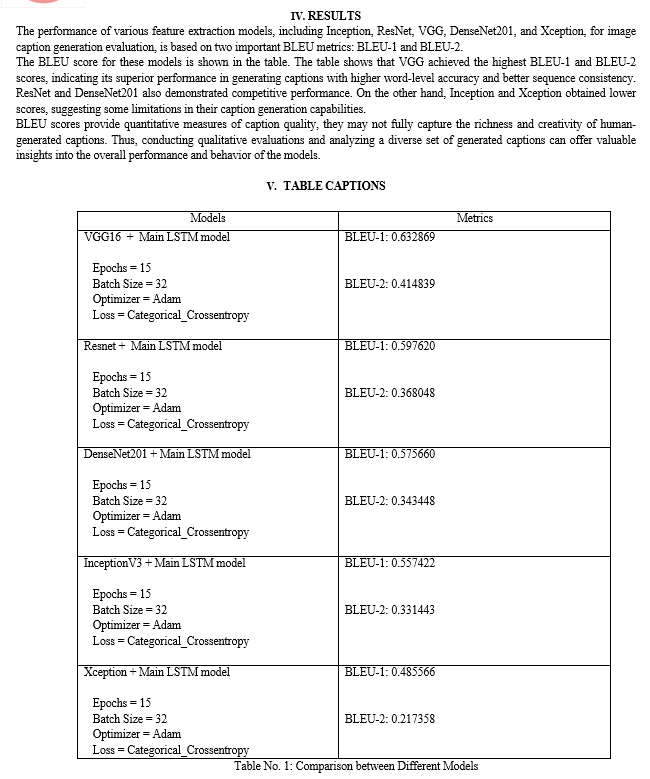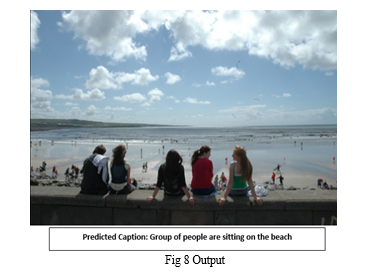Ijraset Journal For Research in Applied Science and Engineering Technology
- Home / Ijraset
- On This Page
- Abstract
- Introduction
- Conclusion
- References
- Copyright
A Comparative Study of Feature Extraction Models for Image Caption Generation
Authors: Yugant Gotmare, Shreya Manapure, Tanushree Patre, Vatsalya Sharma
DOI Link: https://doi.org/10.22214/ijraset.2024.61114
Certificate: View Certificate
Abstract
Image caption generation is a challenging task in the field of computer vision and natural language processing. This study presents a comparative analysis of various feature extraction models for image caption generation. The goal is to evaluate the performance and effectiveness of different models in capturing visual features and generating accurate and contextually relevant captions. The feature extraction models considered in this study include ResNet (Residual Neural Network), DenseNet, VGG (Visual Geometry Group), InceptionNet, DenseNet, and XceptionNet. We conduct extensive experiments on the Flickr 8k dataset, utilizing a common architecture for the caption generation task. Evaluation is performed using BLEU scores to assess the quality and similarity of generated captions to human references. Our results indicate varying performance across the different models, with notable differences in BLEU scores. We further discuss the strengths and limitations of each model, providing insights into their suitability for image caption generation. This comparative study contributes to the understanding of the impact of feature extraction models on the performance of image caption generation systems.
Introduction
I. INTRODUCTION
Image caption generation, the task of automatically generating descriptive captions for images, plays a vital role in bridging the gap between visual content and natural language understanding. The recent advancements in deep learning have significantly improved the performance of image captioning systems. One crucial component of such systems is the feature extraction model, responsible for encoding visual information into a form suitable for generating captions.
In this paper, we present a comparative study of different feature extraction models for image caption generation. The primary objective is to analyze and evaluate the performance of various state-of-the-art models in capturing meaningful visual features and producing coherent and contextually relevant captions. Specifically, we focus on the comparison of ResNet (Residual Neural Network), DenseNet, VGG (Visual Geometry Group), InceptionNet, DenseNet, and XceptionNet as feature extraction models. These models have demonstrated remarkable performance in various computer vision tasks and have been widely adopted in image captioning research. We conduct extensive experiments using the popular Flickr 8k dataset, consisting of a diverse collection of images with corresponding human-generated captions. A common architecture is employed to ensure a fair comparison between the different feature extraction models. To assess the quality and similarity of generated captions to human references, we utilize the BLEU (Bilingual Evaluation Understudy) metric, which measures the precision of n-gram matches between the generated and reference captions. Through our experiments and analysis, we aim to provide insights into the strengths and limitations of each feature extraction model for image caption generation. By quantitatively evaluating the performance of these models using BLEU scores, we can draw comparisons and conclude their effectiveness in capturing visual information and generating accurate and contextually relevant captions. The findings of this comparative study will contribute to the understanding of the impact of feature extraction models on the performance of image caption generation systems.
II. RELATED WORK
The study aimed to investigate how captions can improve picture understanding using transfer learning models, notably Inception V3-ARNN, VGG16-RNN, and VGG16-RNN with BLEU. The researchers used a variety of beam search techniques including bi-directional RNN while comparing various models. The I-ARNN model achieved the lowest loss of 3.0904 for the 10th epoch in the evaluation based on training and validation loss, followed by the I-RNN model at 3.1463.
After a specific number of epochs, the RNN model showed a constant validation loss, whereas the ARNN model preserved variability because of its bi-directional and time-distribution layers. Last but not least, the I-ARNN model outperformed previous InceptionV3 transfer learning models, providing more accurate captions when creating captions for testing images using a beam search parameter of k=3.
The development of recurrent neural networks (RNNs) with long short-term memory (LSTM) units for image captioning. The study shows that their method, known as CNN, performs as well as the baseline on the difficult MSCOCO dataset while requiring less time to train each parameter individually. 113,287 photos make up the training dataset, and 5,000 images each for validation and testing. The researchers also present CNN+Attn, a technique that combines attention mechanisms.
A huge number of object detectors are applied to the image to produce captions, producing several high-scoring detections. Using an intersection/union threshold of 0.3, these detections are combined into groups based on the overlapping regions. Each group in the image depicts a different thing and each group receives its object node. By using this method, it is possible to prevent the prediction of several object labels for the same area of an image, which can occur when various object detectors pick up the same thing. The researchers also scan the image with item detectors, creating nodes for the stuff categories with the best detections.
The work compares the performance of LSTM and GRU architectures for accurately describing images or surroundings such as humans using the BLEU score. The model employs a VGG16 architecture for picture feature extraction, integrating 3*3 convolution and max pooling layers. Tokenized captions are converted into dense vectors of 256 by 34 by an Embedding layer. A CNN encodes images into vector representations, while an RNN decoder generates descriptive words based on learned image attributes. This method has numerous uses in robotic vision and business.
Progress has been made as picture augmentation, picture feature extraction using VGG16, text cleaning, tokenization, and LSTM-based caption synthesis are all part of the proposed system. It ensures various and accurate captions by tokenizing the text and mapping words to integer indices. The LSTM model is then trained on the pre-processed text and visual characteristics to generate descriptive captions, and its performance is measured using the BLEU score, which measures similarity to ground-truth captions. Because of the system's adaptability, it can generate text and voice descriptions for input photos, making it useful in a variety of industries like education, research, social media, news outlets, and mobile applications.
III. METHODOLOGY
A. Dataset Description
The dataset used in this study is the Flickr 8k dataset, which serves as a benchmark collection for sentence-based image description and search. It consists of 8,000 images, each paired with five different captions, providing clear descriptions of the salient entities and events epicted in the images.
The images in the dataset were selected from six different Flickr groups, ensuring a diverse representation of scenes and situations. Notably, the dataset tends to avoid well-known people or locations, focusing on capturing a variety of everyday scenes. This characteristic enhances the generalizability of the dataset to real-world scenarios.
Preprocessing steps were performed on the dataset to prepare it for the experiments. This includes resizing the images to a consistent resolution and ensuring the captions are clear and relevant to the corresponding images. We manage to delete all digits, special characters and remove additional spaces from the captions. These preprocessing steps help maintain the integrity and consistency of the dataset for accurate evaluation and analysis.
The availability of multiple captions per image offers rich contextual information and allows for capturing diverse perspectives and descriptions. This aspect of the dataset contributes to the evaluation of the image captioning models in generating meaningful and diverse captions for a given image.
By incorporating the Flickr 8k dataset into our study, we aim to evaluate and compare the performance of various feature extraction models for image caption generation using a diverse and well-established benchmark collection.

B. Feature Extraction Models
To extract relevant and meaningful visual features from the images, we explore several popular and state-of-the-art pre-trained deep learning models for feature extraction. These models include ResNet (Residual Neural Network), DenseNet, VGG (Visual Geometry Group), InceptionNet, DenseNet, and XceptionNet. Each of these models has demonstrated strong performance in various computer vision tasks and has been widely adopted in the research community.
We describe the architecture and characteristics of each feature extraction model in detail. These models are chosen based on their ability to capture and represent the visual information in the images effectively. By leveraging the pre-trained weights of these models, we aim to extract high-level features that can capture the salient visual attributes necessary for generating accurate and descriptive captions.
The feature extraction models are utilized to process the input images from the Flickr 8k dataset. The extracted features serve as the input for the subsequent image captioning architecture, enabling the generation of captions that align with the visual content of the images.
1) ResNet (Residual Neural Network): ResNet is a deep neural network architecture that has made significant advancements in various computer vision tasks. For feature extraction, we employed the ResNet50 variant, which consists of 50 layers and is pre-trained on the ImageNet dataset. The ResNet50 architecture incorporates residual connections, which enable the model to effectively address the problem of vanishing gradients and facilitate the training of very deep networks. It consists of a series of residual blocks, with each block containing multiple convolutional layers and skip connections that bypass some of the layers. These skip connections help propagate gradients more effectively and allow the model to learn both shallow and deep features simultaneously.






Conclusion
In this study, we conducted a comprehensive analysis and comparison of various feature extraction models for image caption generation. We explored five prominent models, including Inception, Resnet, VGG, DenseNet201, and Xception, to extract image features that serve as input to our image captioning architecture. The results revealed that Vgg achieved the highest BLEU-1 and BLEU-2 scores, indicating its superior performance in generating accurate and contextually relevant captions for images. Resnet and DenseNet201 also demonstrated competitive performance, while Inception and Xception exhibited slightly lower scores. The experiments highlight the importance of selecting appropriate feature extraction models to improve the image captioning process. While this study provides valuable insights into the effectiveness of various feature extraction models for image caption generation, there are several avenues for future research. Firstly, exploring novel techniques for feature extraction, such as attention mechanisms, could further enhance the quality of image representations. Investigating transfer learning and fine-tuning strategies specific to image captioning tasks may yield improved performance across different datasets. Furthermore, incorporating advanced natural language processing techniques and language models like BERT could lead to more contextually rich and diverse captions. Moreover, considering the impact of different evaluation metrics and exploring ensemble techniques could provide a more comprehensive understanding of model performance.
References
[1] Takkar, Sahil, Anshul Jain, and Piyush Adlakha. \"Comparative study of different image captioning models.\" 2021 5th International Conference on Computing Methodologies and Communication (ICCMC). IEEE, 2021 [2] Katiyar, Sulabh, and Samir Kumar Borgohain. \"Comparative evaluation of CNN architectures for image caption generation.\" arXiv preprint arXiv:2102.11506 (2021). [3] Aneja, Jyoti, Aditya Deshpande, and Alexander G. Schwing.\"Convolutional image captioning.\" Proceedings of the IEEE conference on computer vision and pattern recognition. 2018. [4] Chen, Xinlei, and C. Lawrence Zitnick. \"Learning a recurrent visual representation for image caption generation.\" arXiv preprint arXiv:1411.5654 (2014). [5] Vinyals, Oriol, et al. \"Show and tell: A neural image caption generator.\" Proceedings of the IEEE conference on computer vision and pattern recognition. 2015. [6] Kulkarni, Girish, et al. \"Babytalk: Understanding and generating simple image descriptions.\" IEEE transactions on pattern analysis and machine intelligence 35.12 (2013): 2891-2903. [7] M. Young, The Technical Writer’s Handbook. Mill Valley, CA: University Science, 1989 [8] Sharma, Grishma, et al. \"Visual image caption generator using deep learning.\" 2nd international conference on advances in Science & Technology (ICAST). 2019. [9] Kinghorn, Philip, Li Zhang, and Ling Shao. \"A region-based image caption generator with refined descriptions.\" Neurocomputing 272 (2018): 416-424 [10] Indumathi, N., et al. \"Apply Deep Learning-based CNN and LSTM for Visual Image Caption Generator.\" 2023 3rd International Conference on Advance Computing and Innovative Technologies in Engineering (ICACITE). IEEE, 2023.
Copyright
Copyright © 2024 Yugant Gotmare, Shreya Manapure, Tanushree Patre, Vatsalya Sharma. This is an open access article distributed under the Creative Commons Attribution License, which permits unrestricted use, distribution, and reproduction in any medium, provided the original work is properly cited.

Download Paper
Paper Id : IJRASET61114
Publish Date : 2024-04-27
ISSN : 2321-9653
Publisher Name : IJRASET
DOI Link : Click Here
 Submit Paper Online
Submit Paper Online

